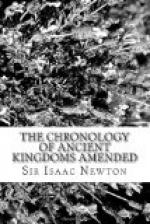To the twelve Lunar months [54] the ancient Greeks added a thirteenth, every other year, which made their Dieteris; and because this reckoning made their year too long by a month in eight years, they omitted an intercalary month once in eight years, which made their Octaeteris, one half of which was their Tetraeteris: And these Periods seem to have been almost as old as the religions of Greece, being used in divers of their Sacra. The [55] Octaeteris was the Annus magnus of Cadmus and Minos, and seems to have been brought into Greece and Crete by the Phoenicians, who came thither with Cadmus and Europa, and to have continued ’till after the days of Herodotus: for in counting the length of seventy years [56], he reckons thirty days to a Lunar month, and twelve such months, or 360 days, to the ordinary year, without the intercalary months, and 25 such months to the Dieteris: and according to the number of days in the Calendar year of the Greeks, Demetrius Phalereus had 360 Statues erected to him by the Athenians. But the Greeks, Cleostratus, Harpalus, and others, to make their months agree better with the course of the Moon, in the times of the Persian Empire, varied the manner of intercaling the three months in the Octaeteris; and Meton found out the Cycle of intercaling seven months in nineteen years.
The Ancient year of the Latines was also Luni-solar; for Plutarch [57] tells us, that the year of Numa consisted of twelve Lunar months, with intercalary months to make up what the twelve Lunar months wanted of the Solar year. The Ancient year of the Egyptians was also Luni-solar, and continued to be so ’till the days of Hyperion, or Osiris, a King of Egypt, the father of Helius and Selene, or Orus and Bubaste: For the Israelites brought this year out of Egypt; and Diodorus tells [58] us that Ouranus the father of Hyperion used this year, and [59] that in the Temple of Osiris the Priests appointed thereunto filled 360 Milk Bowls every day: I think he means one Bowl every day, in all 360, to count the number of days in the Calendar year, and thereby to find out the difference between this and the true Solar year: for the year of 360 days was the year, to the end of which they added five days.




